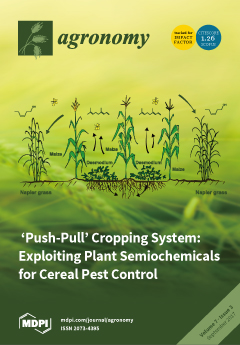Abiotic stress can alter key physiological constituents and functions in green plants. Improving the capacity to monitor this response in a non-destructive manner is of considerable interest, as it would offer a direct means of initiating timely corrective action. Given the vital role that plant pigments play in the photosynthetic process and general plant physiological condition, their accurate estimation would provide a means to monitor plant health and indirectly determine stress response. The aim of this work is to evaluate the response of leaf chlorophyll and carotenoid (C
t) content in wheat (
Triticum aestivum L.) to changes in varying application levels of soil salinity and fertilizer applied over a complete growth cycle. The study also seeks to establish and analyze relationships between measurements from a SPAD-502 instrument and the leaf pigments, as extracted at the anthesis stage. A greenhouse pot experiment was conducted in triplicate by employing distinct treatments of both soil salinity and fertilizer dose at three levels. Results showed that higher doses of fertilizer increased the content of leaf pigments across all levels of soil salinity. Likewise, increasing the level of soil salinity significantly increased the chlorophyll and C
t content per leaf area at all levels of applied fertilizer. However, as an adaptation process and defense mechanism under salinity stress, leaves were found to be thicker and narrower. Thus, on a per-plant basis, increasing salinity significantly reduced the chlorophyll (Chl
t) and C
t produced under each fertilizer treatment. In addition, interaction effects of soil salinity and fertilizer application on the photosynthetic pigment content were found to be significant, as the higher amounts of fertilizer augmented the detrimental effects of salinity. A strong positive (R
2 = 0.93) and statistically significant (
p < 0.001) relationship between SPAD-502 values and Chl
t and between SPAD-502 values and C
t content (R
2 = 0.85) was determined based on a large (
n = 277) dataset. We demonstrate that the SPAD-502 readings and plant photosynthetic pigment content per-leaf area are profoundly affected by salinity and nutrient stress, but that the general form of their relationship remains largely unaffected by the stress. As such, a generalized regression model can be used for Chl
t and C
t estimation, even across a range of salinity and fertilizer gradients.
Full article





